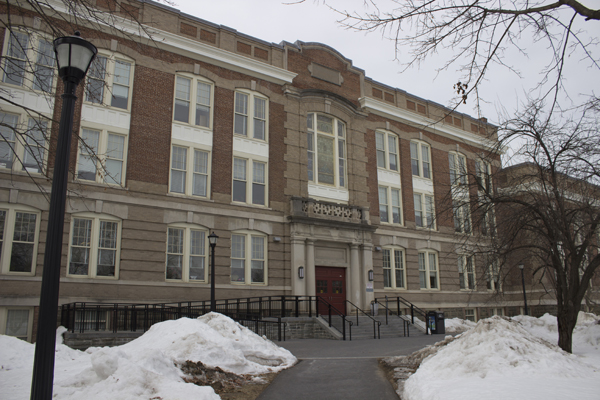

SUNY New Paltz was granted an award by the village of New Paltz’s Historic Preservation Commission (HPC) to recognize Old Main’s historical restoration project that brought back the features of the 107-year-old building’s original appearance.
The award, “Partners in Preservation,” given on Feb. 12, was designed to not only applaud the efforts of the historically conscious, but to instill in others the decision to preserve rather than renovate a building is well appreciated by the commission.
Old Main, the oldest building on campus, was built in 1907 and was originally the institution’s only site for college offices, classes and athletics. In 1948, it became officially recognized as the first entity of the State University at New Paltz and is now home to the College’s School of Education.
HPC Chairman and SUNY New Paltz English Professor Thomas Olsen said that although other places in New Paltz have been given the Preservation Award, such as Cafeteria and P&G’s Restaurant, Old Main is the first non-commercial and non-residential building the commission has recognized, as well as the first college-owned property.
“I think my colleagues [and I] on the HPC recognized that the college did a stunning job of re-purposing a 100 year-old building, preserving its exterior but also making the interior a fully-functioning space designed for the twenty-first century,” he said. “Old Main is a noble building and speaks to the college’s history [and] we were glad to see it so painstakingly preserved and made, again, the centerpiece of the historic quad, which the college has also improved with better walkways and plantings.”
Old Main was renovated once between its construction and its 2011 preservation project. According to Assistant Vice President of Facilities John Shupe, Old Main was subject to an all-around overhaul in the early 1960s, where nearly all of the period-correct architectural detail was removed from the building completely.
“As part of this project we reintroduced those elements that would have been found in the building when it was first constructed in 1907,” he said. “These new reproduction elements included schoolhouse pendent ceiling light fixtures, traditional wood flooring and proper molding and trim details. The building renovation has added some enhanced classrooms and some much needed offices to the School of Education. The building is also now equipped with handicap accessibility and much more energy efficient.”
Shupe also said since there are so many buildings of varying architectural eras on campus, he believes that any of the college’s buildings could possibly be a contender for this award in the future.
“Historic preservation is a very important element of what we do as part of our campus capital asset preservation program,” he said. “It is an honor for the college to receive this type of an award, especially since it is given to us by members of our local community who know a great deal about historic preservation.”
Olsen said the college has taken a “wonderful” step forward in setting a precedent to architectural preservation within the entire village and hopes that more people are encouraged to preserve rather than renovate structures with rich historic value in the future.
“I think everyone in the preservation community feels the same: there is good reason to preserve the streetscape-in this case, the campus-scape — created by older structures because by doing so we remain connected to our past and to our sense of place,” Olsen said. “There is always development pressure to tear down and rebuild, but in many cases what is lost is far more valuable than what might be gained. Re-purposing older structures is often more costly, but doing so preserves our collective sense of the past, of who we are and where we came from.”
